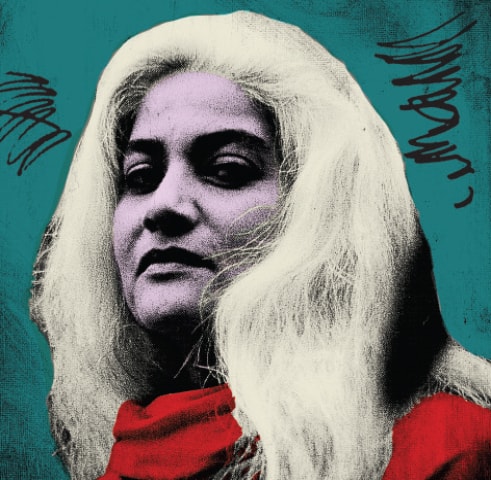
Every so often we see a Banyan sapling growing at an impossible location high up on a tall building, like a poet flourishes in the stifling sameness of society. Order and disorder is a theme explored by scientists and artists alike. The scientists call it ‘entropy’ or a gradual decline into disorder. The artist embraces disorder, finding in it patterns of order.
One of the best ways of awakening the creative process in art students is to send them out to the ‘dishevelled outside’ and ask them to structure something using found materials. Very soon, they start grouping apparently disparate objects by colour, shape, texture or size, experiencing the calmness that such activities generate. Entropy is also not seen in negative terms but rather as “perfect internal disorder” that will inevitably find equilibrium.
Historian Henry Adams said, “Chaos was the law of nature; order was the dream of man.” In his essay ‘The Emerging Science of Spontaneous Order,’ Steven Strogatz says that while nature is always moving towards a state of disorder “all around us we see magnificent structures — galaxies, cells, ecosystems and human beings — that have all somehow managed to assemble themselves.”
This phenomenon is observed by scientists and actively created by artists, musicians, writers, poets and dancers.
Imran Qureshi’s work ‘And How Many Rains Must Fall Before the Stains Are Washed Clean,’ where seemingly chaotic blood spatter is made up of carefully drawn red leaves, Rashid Rana’s assembling of a myriad small, often disruptive, pictures to make up a serene meta-image and Andy Goldsworthy’s ordering of fallen autumn leaves or flowers are all powerful examples of the ability of art to bring order to disorder.
Whether the atonal music of Schoenberg, or the majestic sweeping compositions of Beethoven, Michelangelo’s sculpted slaves extracting themselves from jagged marble, the taan of a gayik, the phrasing of a jazz musician or Isadora Duncan’s flowing scarves, the creative spirit revels in taming chaos, constantly bringing us back from disorder to order. As Einstein says, “Order is needed by the ignorant but it takes a genius to master chaos.”
Muzaffer Warsi in his hymn to God , reminds us: “Talaash us ko na kar buton mein, wo hai badaltii hu’ii ruton mein/jo din ko raat aur raat ko din banaa rahaa hai” (Do not search for Him in the idols, He is in the changing seasons/ The One who is changing day to night and night to day).
We currently live in such a complex time that simple evaluations of order and disorder are almost impossible. The US Army uses the acronym VUCA to describe the present global situation — Volatile, Uncertain, Complex and Ambiguous.
Just as the organised chaos of nature has inspired philosophers and artists, so too has the man-made chaos of society. Ghalib wrote his best poetry against the backdrop of a crumbling Mughal empire; Iqbal developed his philosophy of Asrar-i-Khudi (Secrets of the Self) a year after his mother died and, in the midst of WWI, Payam-i-Mashriq (The Message of the East) and Bang-i-Dara (The Sound of the Bell) as the Khilfat came to an end. Jazz, tap dancing and the blues grew out of the despair of slavery, lynchings and segregation.
It seems that extreme provocation of social discord whether of war, politics or economic mayhem awakens the eloquent. Muhammad Ali Jauhar wrote that “Meri Ibteda Hai Teri Inteha Ke Baad.” Faiz Ahmed Faiz, Habib Jalib, Lorca, Pablo Neruda, Bob Dylan, Mahmoud Darwish and Maya Angelou responded to destructive forces with exquisite poetic elegance.
The creative process almost needs chaos to inspire poetic order. Psychologist, Kathleen Vohs, conducted a study in which she tested creative output by placing one group in a neat room, the other in a messy room. The volunteers in the messy room were far more creative. Order and disorder are interactive and cyclical, the one leading to the other rather than true opposites. The creative spirit enables a new cycle of order and disorder to begin.
We currently live in such a complex time that simple evaluations of order and disorder are almost impossible. The US Army uses the acronym VUCA to describe the present global situation — Volatile, Uncertain, Complex and Ambiguous. The whole world is traumatised by sequential wars that make little sense and we are baffled by engineered truths and fictions. Nothing is what it seems. In his essay ‘The Sound of Surprise, On Order, Disorder, Creativity and Trust’, Alfonso Montuori writes, “The great plots of our novels written by the great Biblical, scientific, Marxist, capitalist, romantic novelists (choose your God) are crumbling.”
So what unseen process is bringing order to this disorder? What creative spirit will quieten or awaken humanity? In Isaac Asimov’s favourite story ‘The Last Question’, the computer named Multivac is asked how the current entropy will end. Its answer is “insufficient data for meaningful answer.”
Activists, writers, artists, poets, dramatists, musicians and filmmakers may not have the immediate impact of political or legal countermeasures, but their messages have the power to be internalised and assimilated as a frame of reference.
Durriya Kazi is a Karachi-based artist and heads the department of visual studies at the University of Karachi
Published in Dawn, EOS, March 11th, 2018













































